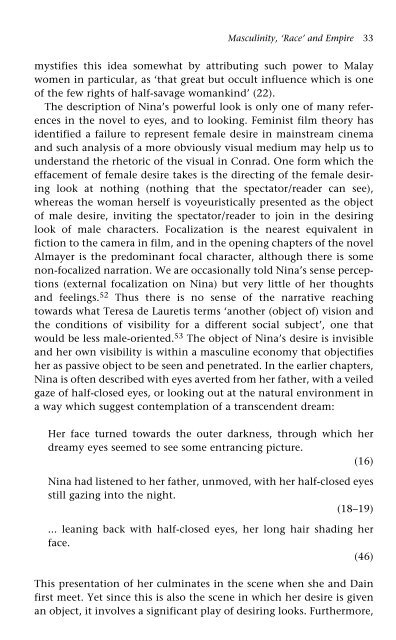Conrad and Masculinity
Conrad and Masculinity
Conrad and Masculinity
You also want an ePaper? Increase the reach of your titles
YUMPU automatically turns print PDFs into web optimized ePapers that Google loves.
<strong>Masculinity</strong>, ‘Race’ <strong>and</strong> Empire 33<br />
mystifies this idea somewhat by attributing such power to Malay<br />
women in particular, as ‘that great but occult influence which is one<br />
of the few rights of half-savage womankind’ (22).<br />
The description of Nina’s powerful look is only one of many references<br />
in the novel to eyes, <strong>and</strong> to looking. Feminist film theory has<br />
identified a failure to represent female desire in mainstream cinema<br />
<strong>and</strong> such analysis of a more obviously visual medium may help us to<br />
underst<strong>and</strong> the rhetoric of the visual in <strong>Conrad</strong>. One form which the<br />
effacement of female desire takes is the directing of the female desiring<br />
look at nothing (nothing that the spectator/reader can see),<br />
whereas the woman herself is voyeuristically presented as the object<br />
of male desire, inviting the spectator/reader to join in the desiring<br />
look of male characters. Focalization is the nearest equivalent in<br />
fiction to the camera in film, <strong>and</strong> in the opening chapters of the novel<br />
Almayer is the predominant focal character, although there is some<br />
non-focalized narration. We are occasionally told Nina’s sense perceptions<br />
(external focalization on Nina) but very little of her thoughts<br />
<strong>and</strong> feelings. 52 Thus there is no sense of the narrative reaching<br />
towards what Teresa de Lauretis terms ‘another (object of) vision <strong>and</strong><br />
the conditions of visibility for a different social subject’, one that<br />
would be less male-oriented. 53 The object of Nina’s desire is invisible<br />
<strong>and</strong> her own visibility is within a masculine economy that objectifies<br />
her as passive object to be seen <strong>and</strong> penetrated. In the earlier chapters,<br />
Nina is often described with eyes averted from her father, with a veiled<br />
gaze of half-closed eyes, or looking out at the natural environment in<br />
a way which suggest contemplation of a transcendent dream:<br />
Her face turned towards the outer darkness, through which her<br />
dreamy eyes seemed to see some entrancing picture.<br />
(16)<br />
Nina had listened to her father, unmoved, with her half-closed eyes<br />
still gazing into the night.<br />
(18–19)<br />
... leaning back with half-closed eyes, her long hair shading her<br />
face.<br />
(46)<br />
This presentation of her culminates in the scene when she <strong>and</strong> Dain<br />
first meet. Yet since this is also the scene in which her desire is given<br />
an object, it involves a significant play of desiring looks. Furthermore,




